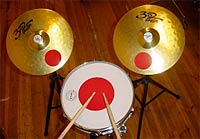The Different Approaches
There are three different Swedish music therapy training programmes. All three approaches lead to different branches that all lead to a professional degree in music therapy.
- The Royal College of Music in Stockholm offers a psychodynamic approach. This approach combines different models, methods and perspectives. It is rooted in humanistic and existential schools of thought, as well as symbolisation processes anchored in psychology and aesthetics. (Paulander, 2011).
- The second branch is called "Guided Imagery and Music” (GIM), a music-assisted form of therapy that was developed in the United States during the 1970’s. The aim is to support, influence and stimulate a person's capacity to create mental images, as well as the person's feelings, memories and bodily sensations. It is a means of confronting and processing inner conflicts, life crises, repressed and traumatic memories, as well as psychosomatic issues. The GIM-programme is currently being taught by Expressive Arts Stockholm AB in Stockholm. (Paulander, 2011).
-
 Since the late 1980’s, The Music Therapy Institute in Uppsala as well as The Ingesund School of Music in Karlstad have both offered programmes in "Functionally Oriented Music Therapy". Functionally Oriented Music Therapy is a music-assisted method that is only offered on a one-to-one basis. (Paulander, 2011). The FMT-method was created in Sweden during the latter half of the 1970’s. The purpose of the treatment is to regenerate, build or stimulate the growth of perceptual-, motor- and cognitive skills in the nervous system and the brain. FMT music therapist courses are currently being arranged by:
Since the late 1980’s, The Music Therapy Institute in Uppsala as well as The Ingesund School of Music in Karlstad have both offered programmes in "Functionally Oriented Music Therapy". Functionally Oriented Music Therapy is a music-assisted method that is only offered on a one-to-one basis. (Paulander, 2011). The FMT-method was created in Sweden during the latter half of the 1970’s. The purpose of the treatment is to regenerate, build or stimulate the growth of perceptual-, motor- and cognitive skills in the nervous system and the brain. FMT music therapist courses are currently being arranged by: - Eskilstuna Folkhögskola
(The Eskiltuna Folk High School – a two year-long distance course) - Lärosätet och centret för FMT-metoden
(The FMT center and seat of learning)
- Eskilstuna Folkhögskola